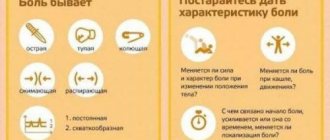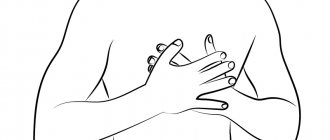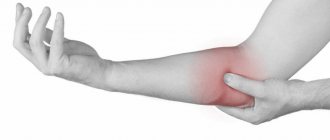Pain and burning under the ribs on both sides are common symptoms that indicate diseases of the liver, pancreas, gallbladder and biliary tract.
Often these signs are the main ones, since they prevail in severity. There are additional symptoms in the form of bloating, nausea, vomiting, bitterness in the mouth, loss of appetite, weakness, depression and emotional instability.
If the right and left sides hurt at the same time, a comprehensive diagnosis is required, since many diseases of the hepatobiliary system manifest themselves in this way. Only an accurate diagnosis allows you to create an effective therapeutic strategy to help the patient.
Why it hurts under the ribs on both sides in the front - the main etiology of its occurrence, what liver pathologies are manifested by these signs - in detail in the article.
Possible causes of rib pain
Most often, patients believe that pain occurs in the rib bones, although in fact the discomfort may appear due to muscle spasms or compression of the nerve roots. Main reasons
rib pain:
- pathologies of nerves and muscles;
- excessive physical and psychological stress;
- trauma, rib tumors, Tietze syndrome;
- diseases of the spine (spondylosis, arthrosis, osteochondrosis, hernias and protrusions);
- pathologies of the pleura, including tumors.
Soreness of the rib bones is a relatively rare phenomenon that occurs in severe bone diseases or injuries (fractures). If pain in the ribs appears after a bruise or fall, or a blow to this area, medical attention is required immediately, because a broken rib bone can damage the heart or lungs.
Often discomfort in the chest area accompanies colds or pneumonia. This symptom should be reported to your doctor, as it can be not only muscle spasms due to coughing, but also the consequences of deterioration of the lungs, bronchi or pleura.
Diagnostics
Orthopedic traumatologists are usually involved in determining the cause of pain in the ribs. To determine the nature of the pathology, objective methods and additional studies are used. The diagnostic search program includes:
- Survey.
The doctor clarifies the time and conditions for the onset of pain, the duration and dynamics of pain, and their relationship with external circumstances. Identifies other complaints (difficulty breathing, weakness, fever). - Physical examination
. Includes external examination, palpation, percussion and auscultation of the chest. Allows you to determine the localization of pain, the presence of deformation, swelling, local hyperemia, skin changes, other disorders, assess breathing, and the boundaries of the lungs. - X-ray of the ribs.
Indicated for injuries and tumors of the ribs. Confirms fractures, changes in bone structure. If there is a suspicion of concomitant damage to the chest organs, it is supplemented with chest X-ray, the results of which can detect focal and diffuse pathological processes in the lungs and pleural cavity. - Neurological examination
. Recommended for neurological origin of the disease. Allows you to localize the source of pain impulses, diagnose diseases of the nerves and spinal column, and determine the further direction of the examination.
In case of herpes zoster, an additional examination by a dermatologist is prescribed; in case of oncological diseases, a consultation with an oncologist is prescribed. To clarify the nature of changes in bones, cartilage and soft tissue structures when radiography is insufficient, a CT or MRI of the chest is performed. For tumors, a biopsy is performed followed by cytological or histological examination.
Multiple rib fractures
Features of pain in various ailments
In case of pain in the hypochondrium, which intensifies when pressed and is accompanied by an increase in temperature, you need to call an ambulance. Unpleasant sensations can be caused by inflammation of the gallbladder, diseases of the intestines, liver and kidneys. With these disorders, the pain is often reflected or “smeared,” which may make it seem as if its source is the ribs. With Tietze syndrome, a non-infectious inflammatory process occurs in the costal cartilages. It is characterized by pain that increases with pressure or inhalation. Another dangerous condition, fibromyalgia, is accompanied by damage to soft tissues, which causes severe pain when touched and pressed. This pathology is characterized by morning swelling of the limbs. Often, discomfort is caused by excessive muscle tension. This problem also requires medical consultation, because it can occur with severe pathologies of the spine or neuralgia. How to distinguish neuralgia from osteochondrosis:
- with osteochondrosis, the pain is constant, with neuralgia, unbearable sharp pain in the ribs periodically occurs;
- Osteochondrosis is characterized by overstrain of the back muscles;
- in the case of neuralgia, pain intensifies with pressure.
Other signs may indicate that pain in the costal region is caused by pathologies of the spine:
- frequent dizziness;
- decreased back mobility;
- impaired sensitivity of the limbs;
- a feeling of “current” in the body when moving;
- crunching, crackling when turning and tilting the body;
- numbness in the chest, back, buttocks, arms;
- pressure surges.
The cause of pain in the ribs may also lie in spinal deformation. With lordosis, kyphosis and scoliosis, the entire “axis” of the body is disrupted, which causes internal organs and joints to shift, the static load to be incorrectly distributed, and constant muscle tension occurs. What you can do before seeing a doctor if your ribs hurt:
- take a pain reliever;
- wear loose clothing that does not compress the chest;
- lie down;
- try to breathe slowly and smoothly.
Chronic liver diseases in humans
Chronic liver pathologies under the influence of factors - poor nutrition, violation of doctor's recommendations, pregnancy, etc. tend to worsen, which leads to the appearance of a characteristic clinic.
Chronic hepatitis
This is inflammation in the liver, which leads to fibrotic transformations and necrotic changes in cells and tissues, while there is no disruption of the structure of the lobules. Signs of the disease are determined by the degree of damage to the gland and the type of hepatitis.
As the disease progresses, symptoms appear:
- Increased gas formation.
- Decreased appetite.
- Sleep disturbance.
- Headache.
- Loss of body weight.
- Jaundice.
- Periodic pain in the right side.
- Pain on the left side due to the enlargement of the spleen.
- Skin itching.
Based on palpation, the doctor diagnoses diffuse hepatomegaly or an increase in only one lobe, increased liver density.
Fatty degeneration
Fatty liver is an independent syndrome or a secondary one, as a result of which lipid compounds accumulate in the liver tissues.
According to statistics, the disease is most often diagnosed in obese women. In 60-70% of pictures there are no symptoms.
Obvious symptoms of disease progression:
- Abdominal discomfort.
- Aching pain in the right side (mild).
- Hepatomegaly, when touching the right side it hurts.
In some cases, fatty liver is accompanied by dyspeptic disorders and jaundice.
Cirrhotic lesion
Cirrhosis is a disease in which full-fledged liver tissue degenerates into fibrous connective structures. The severity of the clinic is based on the degree of damage to the gland and the activity of cirrhotic processes. At the initial stage, manifestations are minimal, there is no pain.
Over time, discomfort appears under the ribs, digestion is disrupted, and the temperature increases to the level of low-grade fever. As the pain progresses, it intensifies and radiates to different parts of the abdomen and back; jaundice is observed, characteristic signs are redness of the palms, transformation of the nail plates, spider veins on the body.
Tumor neoplasms
Neoplasms of benign (cysts, hemangiomas) and malignant nature (primary, secondary cancer) in the liver do not show symptoms in the initial stages. As the tumor grows, the capsule stretches, which leads to pain.
It can be different - the pain is dull, aching, bursting, sharp. Localization is the right side, irradiation is to the stomach, to the right side under the ribs, to the back, shoulder blade and shoulder. Painful sensations initially appear periodically, but over time they become constant.
Diagnosis for rib pain
Attempts at self-medication can lead to serious consequences, including death. Remember: the sooner you receive medical advice and begin treatment, the lower the price of treatment and the higher its effectiveness. You can contact for help:
- therapist;
- phthisiatrician (if there is a cough, hemoptysis, difficulty breathing, suffocation);
- neurologist, orthopedist (for numbness in the hands, crunching when moving, back pain);
- traumatologist (for bruises, falls and other injuries).
To make a diagnosis, the doctor needs not only a survey of the patient and his examination, but also data from laboratory tests and instrumental studies:
- ECG;
- radiography;
- MRI, CT;
- blood and urine tests;
- and other types of examination.
Classification of pain, pain of different localizations
The most common are acute pains radiating to the back and ribs.
They are temporary. Only in 10-20% do they develop into a chronic form. Based on localization, pain is divided into: in the lumbar region. Typical for older people. They appear after long walks or excessive stress;
radiating to the back and ribs on the right. It primarily indicates the presence of an inflammatory process;
radiating to the back and ribs on the left. Appears both under load and when stationary. Especially often after a hard day at work or a long trip.
Regardless of where the pain appears, maximum attention should be given to this problem. It is recommended to listen to your own body in order to get rid of unpleasant sensations by eliminating the true cause of the pain. And there are many of them: from banal overwork to disruption of the functioning of internal organs.
Treatment for rib pain
The treatment plan is developed depending on the diagnosis and the reasons for the development of the pathology. For the treatment of cervicothoracic osteochondrosis and other pathologies of the spine and joints, anti-inflammatory and painkillers, antispasmodics, chondroprotectors and muscle relaxants are prescribed. Courses of massage, physiotherapy, manual therapy or osteopathy may also be prescribed.
Massage helps relieve excessive tension and pain, it has a warming and relaxing effect. However, this procedure is unacceptable for acute injuries, colds and cancer.
Physiotherapy and acupuncture help eliminate pain and muscle hypertonicity, normalize metabolic processes, eliminate inflammatory foci, restore damaged tissue and increase local immunity. To strengthen the muscle corset and healthy distribution of static load, physical therapy is necessary, which allows you to relieve spasms, increase muscle mass and correct posture. During treatment and in the future for prevention, it is necessary to follow a daily routine and get enough rest, wear comfortable shoes, avoid hypothermia and eat right.
Treatment
Help before diagnosis
If the pain syndrome is minor and the general condition is satisfactory, it is recommended to limit physical activity for several days and use local anesthetics, warming and anti-inflammatory drugs. If the skin is damaged, ointments and gels should not be applied. If you feel weak, have a fever, or experience severe pain, shortness of breath, cough, or hemoptysis, you should urgently seek medical help.
Conservative therapy
The conservative treatment plan is determined by the nature of the pathology. In most cases, rest is recommended, breathing exercises and physiotherapy are prescribed. In some cases, massage and manual therapy are indicated. Drug therapy may include:
- Analgesics
. For moderate pain, tablets are used; for severe pain, medications are administered intramuscularly. In the later stages of cancer, narcotic drugs are required. - Antibiotics
. For pleurisy, purulent periostitis, osteomyelitis, antibiotic therapy is indicated. First, broad-spectrum drugs are used, then the treatment regimen is adjusted taking into account the sensitivity of the pathogen. - Hormonal agents
. Pain due to intercostal neuralgia and Tietze syndrome is successfully eliminated by blockade with corticosteroids. Blockades are performed when other methods are ineffective; the course includes no more than 3 injections of the drug. - Cytostatics
. Medicines are prescribed for malignant tumors, destroy cancer cells, and slow down the growth of tumors. They can be used as monotherapy or a combination of several agents.
Prevention of radiating back pain
The fundamental and most effective way to prevent any disease, including radiating back pain, is to monitor your own health and the general condition of the body.
Organizing proper nutrition and regular physical activity of moderate intensity are also important. You should also avoid stressful situations as much as possible.
Office workers should carefully select chairs to relieve back strain. A prerequisite is the adjustment of the backrest tilt and seat height depending on individual characteristics.
It is important to control the position of your back. It is necessary to develop the habit of sitting upright without slouching. Exercising during breaks between work is encouraged. It is not recommended to make sudden movements that can cause irreparable damage to the spine.
It is recommended to approach the issue of choosing a pillow and mattress responsibly, since your back should rest during sleep. If you feel back pain after waking up, you should change your bedding. Otherwise, chronic diseases may occur.










